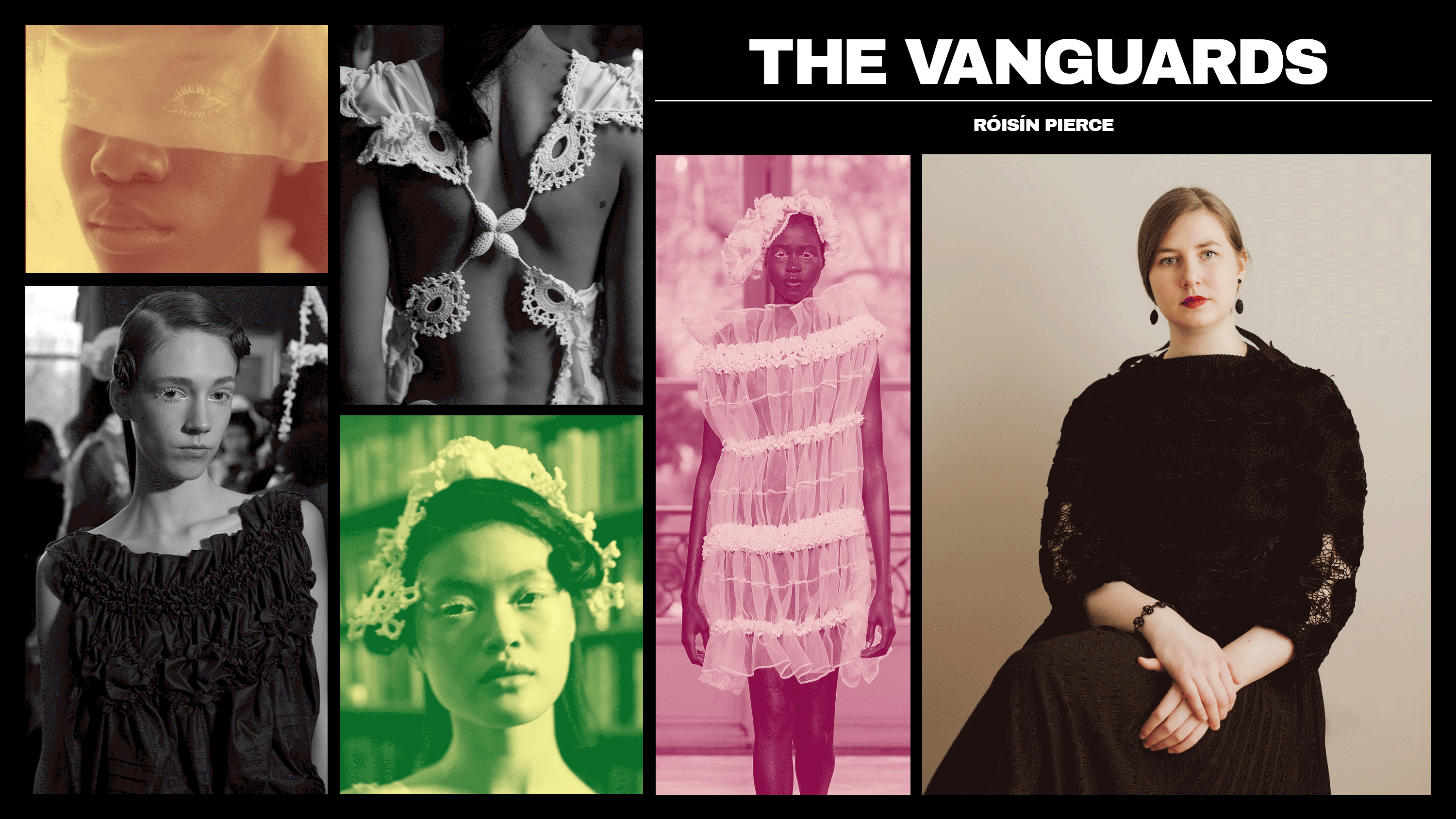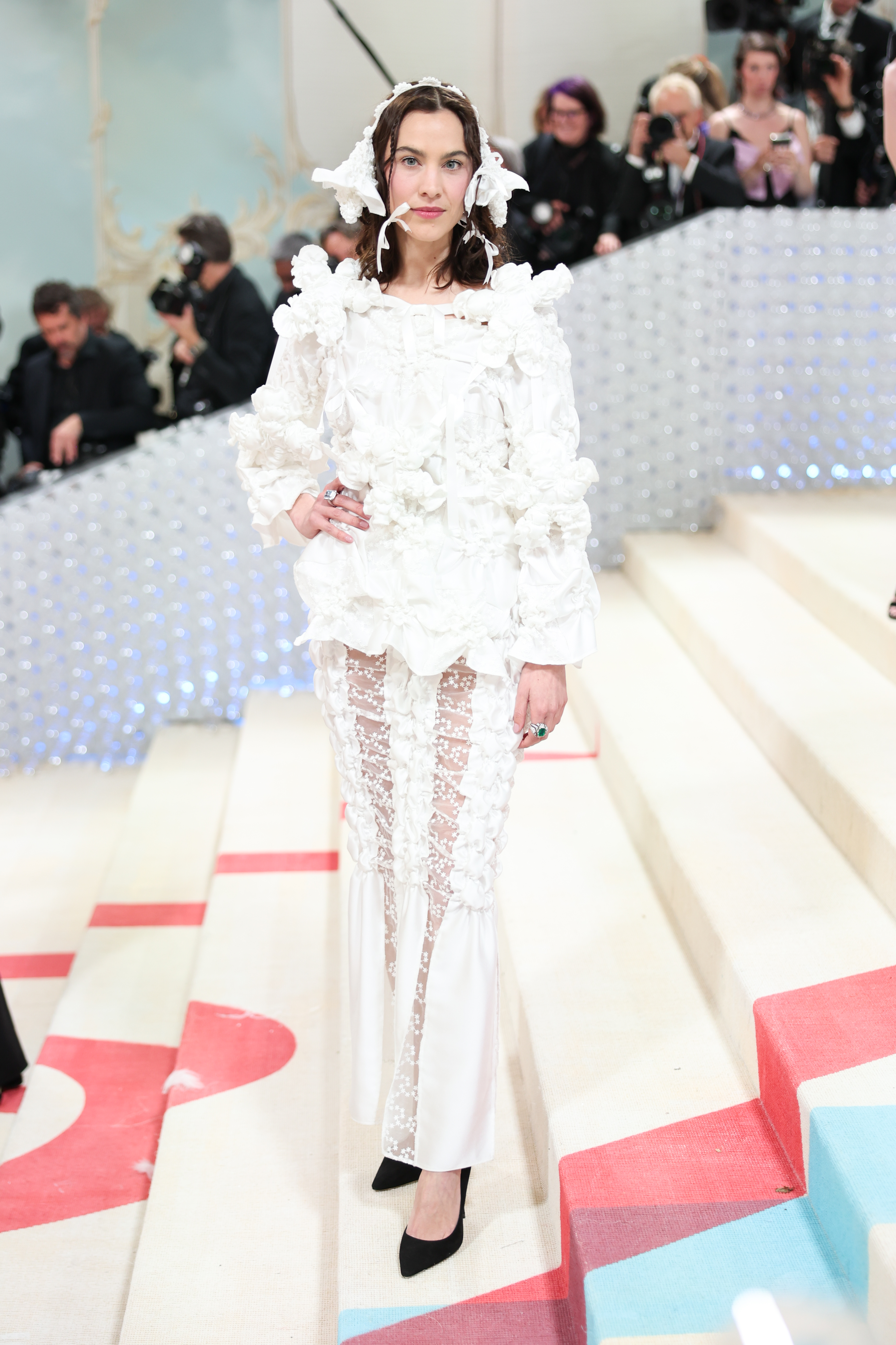Designer Róisín Pierce Is Creating High Fashion From Her Tiny Kitchen Table
Working with her mother out of her Dublin home, the visionary Irish artist makes clothes that tell the story of female resistance.


It’s the day after Saint Patrick’s Day when Róisín Pierce dials in for her call with Marie Claire. The Irish designer spent the holiday hiking Dublin's Wicklow Mountains with her mother Angie, whom she lovingly refers to by her first name. "We saw really small lambs, so that was quite nice," Pierce says with a laugh.
The artist behind her self-titled brand is tuning in from the crowded kitchen table of her Dublin family home. Pierce, framed by bolts of frothy white fabric and mannequins wearing her clothing samples, explains that the room doubles as her workspace. “It's quite a strange thing to do because in your personal time—if you even have that—you can't switch off because you see all the work you could be doing. [My pieces] live here, and I see them every day," says the designer, a Chanel 2019 Métiers d’Art prizewinner and a 2022 LVMH Prize finalist who received both honors before debuting her self-titled brand at Paris Fashion Week in March 2023.
Fortunately, pieces as pretty as Pierce's seamlessly double as decor: ruched white satin-crepe dresses that look like dollops of whipped cream, blouses surrounded by buoyant ribbons of lace, and communion veils in feather-light organza. The designer, whose brand is carried in the concept shop-meets-luxury department store Dover Street Market, is known for her gossamer gowns and intricate tops adorned with various Irish handicrafts—crochet, embroidery, and smocking.

A portrait of Róisín Pierce.
In discussing her brand's origins, Pierce rewinds to her childhood. “I was definitely an odder, different kind of child. I'm dyslexic, so I wasn't ever really that interested in school. I was fascinated with little details in nature or objects and liked to be on my own and to create.” While other kids growing up in the early aughts pleaded for dolls and Tamagotchis, Pierce was enamored by clouds and wanted to draw and make things with her hands. “That's what I really enjoyed. I still am quite like that today,” says the 30-year-old designer.
Pierce pursued her passion for creating with her hands at Dublin National College of Art and Design and developed a fabric-forward design process that others might label as rogue. She doesn’t sketch or create her pieces with any semblance of a plan—“I often don’t know where the pieces are going to go"—but rather takes leads from her textiles just as a rogue chef cooking without a recipe would follow flavor.
Considering her brand’s zero-waste production model, it’s risky to freestyle, but Pierce finds creating with "strips and squares" under such limiting constraints an adrenaline rush. “It's very organic, and I find that very exciting and beautiful," she explains. Adding her unconventional approach to design and an unknown outcome is also quite addictive.

A sampling of etheral looks from Róisín Pierce Fall 2024, a collection called “O lovely one, girl that fell from a star."
While Pierce is the brand's name and face, her business is not a one-woman show. “Angie works with me on all fronts of the brand—the crochet, the fabric decisions, the textile manipulation,” the designer explains. Pierce sings her mom's praises as a skilled craftswoman and recalls her “always making really magnificent things, like little crochet cardigans” throughout her childhood. "[Angie] knows what I'm after," she adds, referring to her mother as somewhat of an extension of herself.
Get exclusive access to fashion and beauty trends, hot-off-the-press celebrity news, and more.
It seems skilled craftsmanship is genetic in the Pierce family—as is innovation. The designer, who studied applied materials and fabric manipulation at Dublin's NCAD, describes her clothing as "three-dimensional soft sculptures." She merges traditional Irish craft techniques—lace and smocking, crochet and patchwork—for an intricate end result that demands closer inspection. "If the piece doesn’t have embroidery overlay, there are floating organza pedals. Then within that are these delicate floral sculptures—you look closer and see little vines of embroidery," says Pierce, who produces collections annually to "respect the type of work" she does.

Ethereal looks from the Fall 2024 collection, featuring floral rosettes, smocking, and tiers of lace-trimmed sheer fabric.
In blending traditional craftsmanship with a modern point of view, Pierce's pieces feel both familiar and futuristic. "Our use of craft is not completely heritage; we fuse the contemporary with the traditional to push things beyond how they've been utilized before and to touch the unknown," says the designer. "We want to create things unlike anything you've seen before."
Adding to her brand's novelty is its all-white color palette. It's a choice that symbolizes "femininity and Irish craft" but also serves as a design facet that highlights her handiwork. "White becomes our color. We overlayer [fabrics] to create transparencies, track lace, and play with print work through the stitching. It's all these highly ornate, fully sculptural delicacies and intricacies that you can see, even in the white," says Pierce.

Alexa Chung in a Róisín Pierce creation at the 2023 Met Gala: Karl Lagerfeld: A Line of Beauty.
The designer deviated from her white color scheme only once—a single indigo dress from Fall 2024 referencing the dove Purgatorio from Dante’s Paradiso, who "dived through these dark waters, swooshing through all this inky blue." The sole blue look was a statement to the industry (“We are not a bridal brand," Pierce asserts) and also a wink at what's to come. "I've made my point in all the white that we've used. As much as I love it from a visual point, it's time for something new in the color zone," she hints.

The ink-blue cotton dress with slight shimmer from Róisín Pierce's Fall 2024 collection.
While her work is sweet and innocent in its aesthetics, Pierce juxtaposes its appearance against the darker historical truths of Irish craftsmanship. Her 2019 debut collection, 'Mná i Bhláth (Women in Bloom), tells the story of the 18th-century Magdalene Laundries, where women who had children out of wedlock were held captive in religious institutions and forced to create needlepoint as carceral punishment.
“The history of [Irish craft] can be very dark, but we transport it to moments of light”—seen in her flouncy floral rosettes, ornate embellishments, and soft ruffles from her first collection five years ago. “In doing that, it lets the craft live on and have its own breathing space so that these dark subjects are not just disturbing,” she explains. “Then, when you peel back and reveal all these layers to my work—not just the decorative layers, but the personal and political layers—it has something to say.”

A close-up look at the crochet detailing in a look from Pierce's Fall 2024 line.
Here, Pierce specifically mentions Irish lace-making, a form of crochet invented during the Great Famine when women mimicked the look of highly desirable Italian lace by using a new form of hook. “The rule back then was that if you were fortunate enough to survive [the famine] and learn lace-making, you'd have to teach two other people. That was how [Irish lace-making] grew,” she explains. Many, Pierce included, credit these women for saving Ireland's economy and for preserving the country's individualistic form of handiwork.
In looking at her nation's past, the Irish iconoclast finds inspiration for her brand’s present. “I was a bit concerned by the lack of preservation for [Irish crochet] and that the people practicing the skill were often of a much older generation. So for 'Beware, Beware' [Róisín Pierce’s Fall 2023], we worked with some local Irish girls to learn lace work with Angie in the family home every Sunday.” When working on the capsule, Pierce, Angie, and the two young women sat at that very same crowded kitchen table and crocheted together every weekend.

A frothy ruched mini dress and headpiece from Róisín Pierce's Fall 2024 collection.
Pierce is careful not to pigeonhole her brand as purely political. Instead, the designer invites paradoxes—“blurry lines of whether the craft is oppressive, liberating, or just expression”—that might get you thinking.
But she also doesn’t mind if you’re drawn to her clothing for how it looks, just as long as it makes you feel something. “What's quite important to us is that they're not just these highly feminine pieces; They can look quite strong and protective, like armor, and people can sense that rawness when wearing them. To give women that strength, to show them new feminine thought, is a beautiful thing.”
Meet The Vanguards, Marie Claire's fashion franchise spotlighting the names to know. Here, the thought-leading designers, both emerging and veteran, provide a peek inside their process.

Emma Childs is the fashion features editor at Marie Claire, where she explores the intersection of style and human interest storytelling. She covers viral, zeitgeist-y moments—like TikTok's "Olsen Tuck" and Substack's "Shirt Sandwiches"—and has written hundreds of runway-researched trend reports. Above all, Emma enjoys connecting with real people about style, from picking a designer's brain to speaking with athlete stylists, politicians, and C-suite executives.
Emma previously wrote for The Zoe Report, Editorialist, Elite Daily, and Bustle and studied Fashion Studies and New Media at Fordham University Lincoln Center. When Emma isn't writing about niche fashion discourse on the internet, you'll find her stalking eBay for designer vintage, doing hot yoga, and "psspsspssp"-ing at bodega cats.